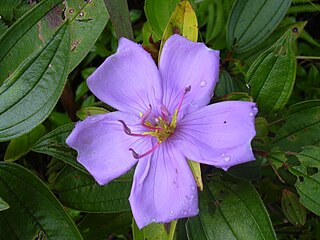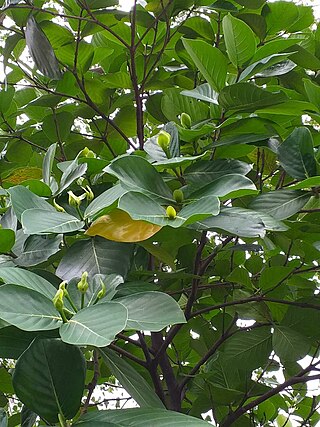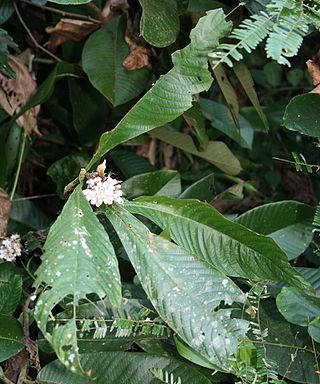
The genus Mitrephora, of family Annonaceae, comprises around 50 species of trees and shrubs found in tropical Asia and northern Australasia. The area of distribution extends from China in the North down to Queensland, Australia in the South. The genus is widely found in southern India and Southeast Asia. It reaches a maximum of diversity in Borneo and the Philippines.

Melastoma is a genus in the family Melastomataceae. It has over 100 species distributed around Southeast Asia, India, north to Japan, south to Australia and the Pacific Islands. The number of species should probably be reduced according to some sources. Many species have been planted around the world for the aesthetic value of their bright purple flowers.

Leea is a genus of plants in the family Vitaceae, subfamily Leeoideae, that are native to parts of central Africa, tropical Asia, Australia and Melanesia. It was previously placed in its own family, Leeaceae, based on morphological differences between it and other Vitaceae genera. These differences include ovule number per locule, carpel number, and the absence or presence of a staminoidal tube and floral disc. Pollen structure has also been examined for taxonomic demarcation, though studies have concluded that the pollen of Leeaceae and Vitaceae suggests the families should remain separate while other studies conclude that Leea should be included in Vitaceae.
Dischidia is a genus of plants in the “dog-bane” family Apocynaceae, collectively known as the “milkweeds”. They are epiphytes, native to tropical areas of China, India as well as Bhutan’s southern borders, wherever minimal frost occurs. Additionally, they are known from most areas of Mainland Southeast Asia, including forested areas of Myanmar, Thailand, Vietnam, Cambodia, Laos, and some parts of Indonesia, Malaysia and Singapore. Several species are also native to Papua New Guinea and northeastern Australia.

Fagraea is a genus of plants in the family Gentianaceae. It includes trees, shrubs, lianas, and epiphytes. They can be found in forests, swamps, and other habitat in Asia, Australia, and the Pacific Islands, with the center of diversity in Malesia.

Lasianthus is a genus of flowering plants in the family Rubiaceae. They are tropical subshrubs, shrubs, or rarely, small trees. They inhabit the understory of primary forests.

Polyalthia is a genus of flowering plants in the family Annonaceae. There are approximately 90 species distributed from Africa to Asia and the Pacific.
Urophyllum is a genus of flowering plant in the family Rubiaceae, native to from south China to Tropical Asia. The genus was established by Nathaniel Wallich in 1824.

Vatica is a genus of plants in the family Dipterocarpaceae. Its species range from India and southern China through Sri Lanka, Indochina, Indonesia, the Philippines, and New Guinea.

Argostemma is a genus of flowering plants in the family Rubiaceae. It can be found in (sub)tropical Asia and western and west-central tropical Africa.
Hedyotis (starviolet) is a genus of flowering plants in the family Rubiaceae. Many species of this genus such as Hedyotis biflora, H. corymbosa and H. diffusa are well known medicinal plants. Hedyotis is native to tropical and subtropical Asia and to islands of the northwest Pacific. It comprises about 115 species. The type species for the genus is Hedyotis fruticosa.

Neonauclea is a genus of flowering plants in the family Rubiaceae. It comprises about 71 species. Neonauclea is a genus of shrubs and trees They are indigenous to China, India, Southeast Asia, Wallacea, New Guinea and Australia.

Dendrophthoe is a genus of hemiparasitic shrubs found in Asia and Australia known as mistletoes. The genus was described by German naturalist Carl Friedrich Philipp von Martius in 1830. Species in this genus have a variety of reported uses in the medical traditions of the region, most notably in Nepal.

Mycetia is a genus of flowering plants in the family Rubiaceae. It includes 54 species, ranging from the Indian subcontinent through Indochina, southern China, and Malesia to New Guinea.

Sonerila is a genus of plants in the family Melastomataceae. This genus is characterized the by presence of three petals as opposed to five in the other members of the family. Most members of the genus prefer growing in shady habitats. It is a large genus including about 175 species.
Ridsdalea is an Asian genus of plants in the family Rubiaceae; it was named after Dr. Colin Ernest Ridsdale (1944–2017), who was an English botanist and Specialist in tropical plants and Rubiaceae family. The type species is Ridsdalea grandis(Korth.) J.T.Pereira, which was renamed from the basionym Gardenia grandis. Several other species have been reassigned from other genera: notably Rothmannia, which is now reserved for African species. Its native range is southern China, Indo-China, Malesia and New Guinea.
Dissochaeta is a genus of plants in the family Melastomataceae. Species can be found in: Hainan and Indo-China through to Malesia.











